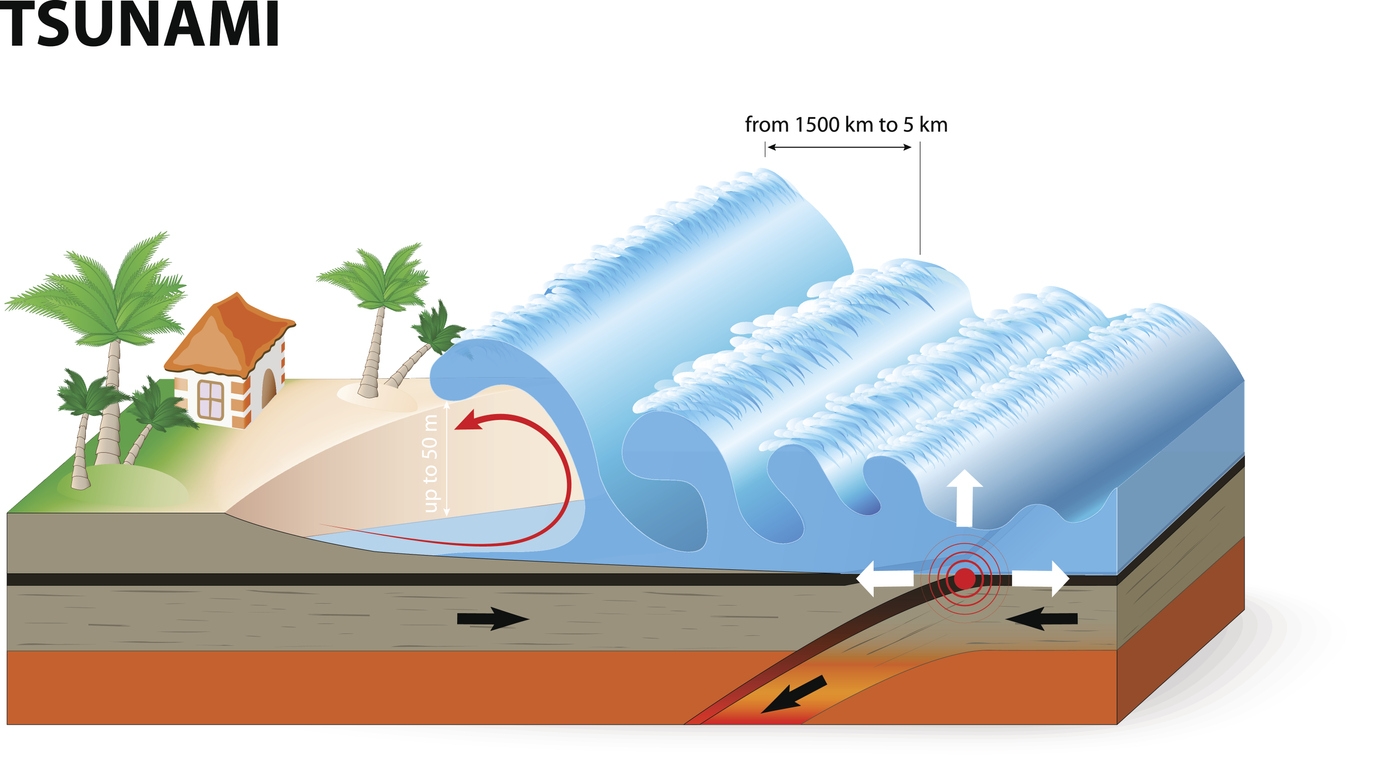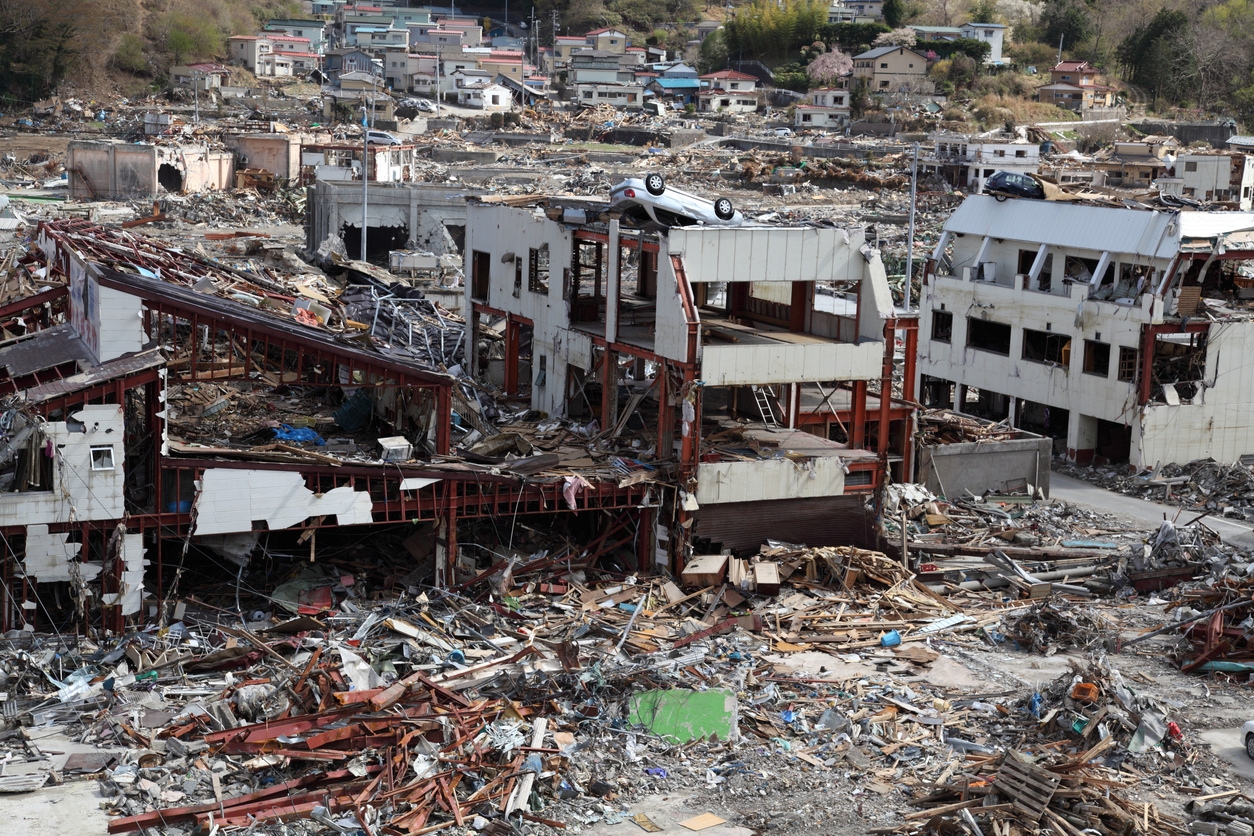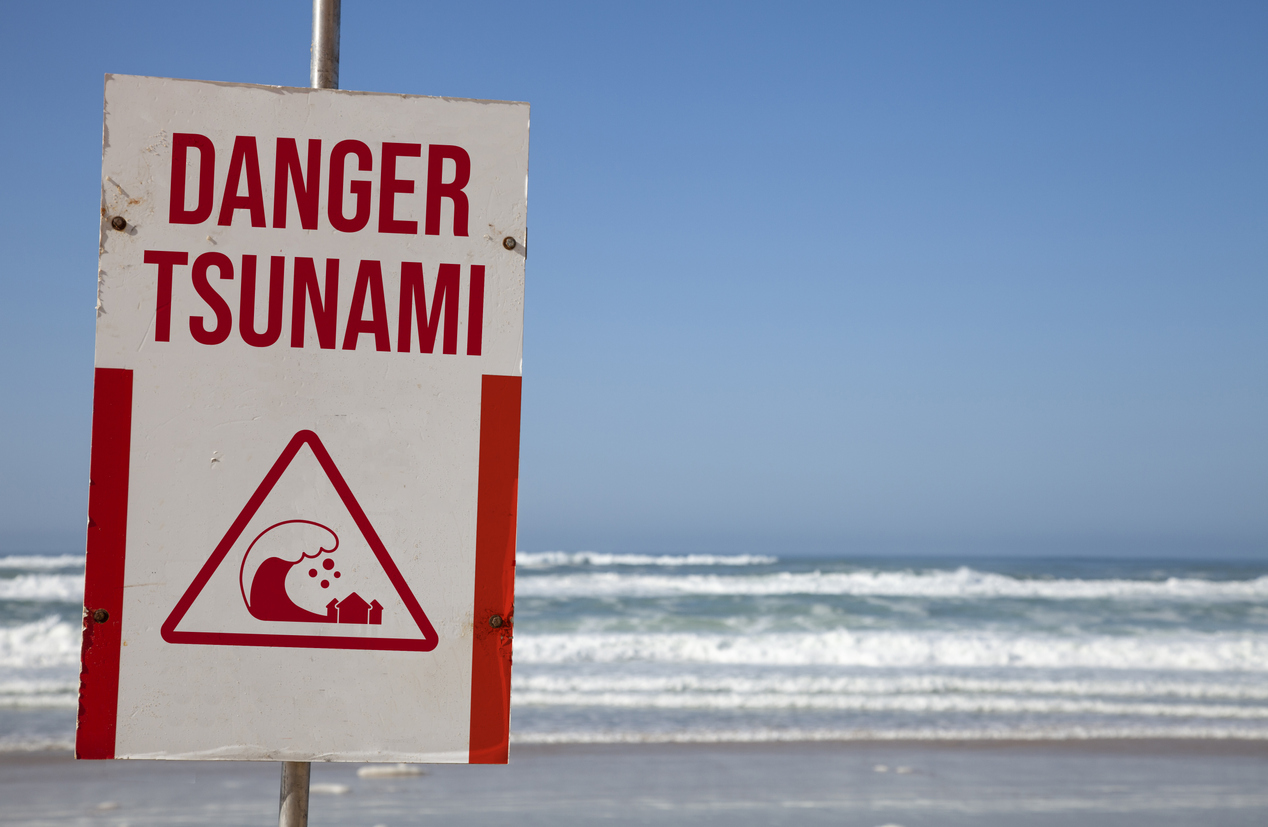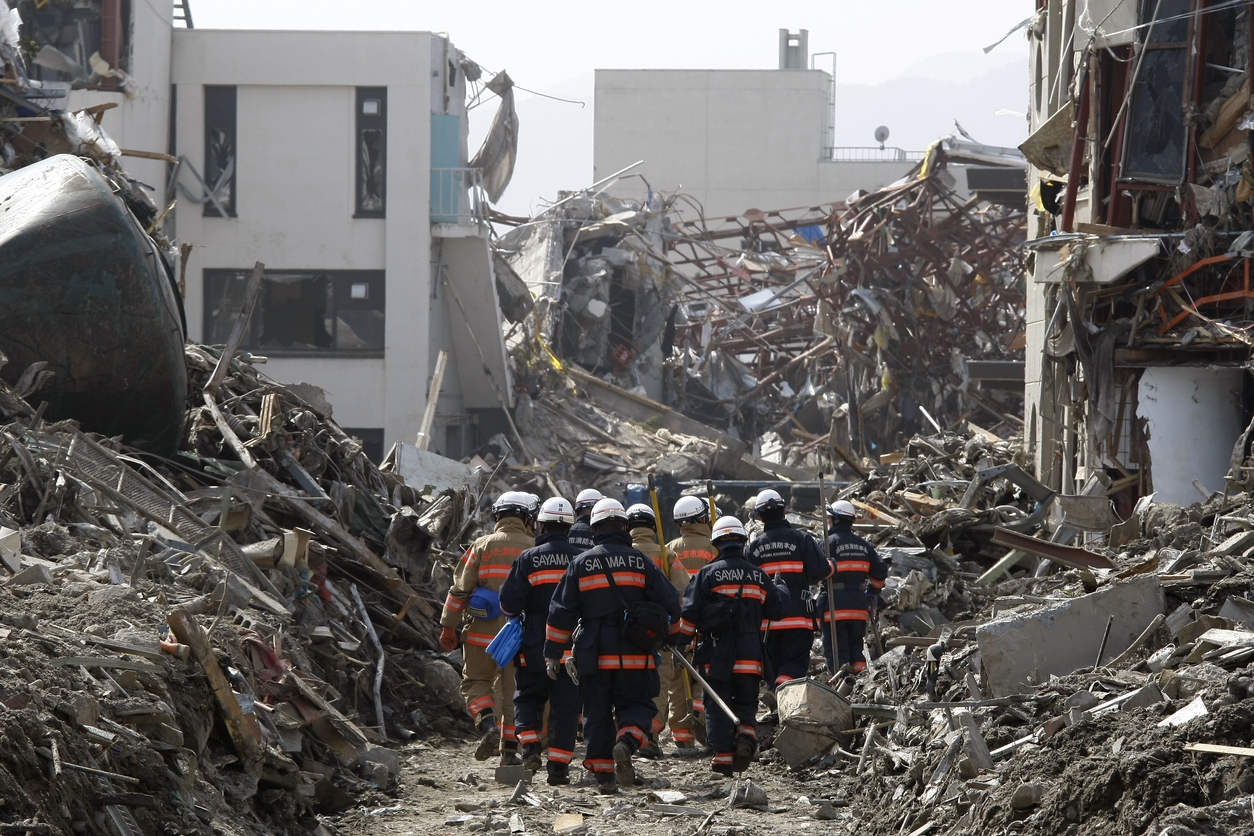Tsunamis stand as testament to the Earth’s power to unleash colossal forces. The word is derived from the Japanese words “tsu” meaning harbor and “nami” meaning wave. It represents a series of ocean waves with extremely long wavelengths and energy. Tsunamis are generally triggered by underwater disturbances such as earthquakes, volcanic eruptions, or landslides. Their destructive potency arises from the sheer energy and ability to traverse vast distances.
Upon reaching coastal areas, they can transform into towering walls of water, inundating coastal communities with devastating consequences. The historical impact of tsunamis highlights the need for vigilant preparation and understanding of these natural forces. In this post, we have rounded up the most destructive tsunami events to understand their impact better. Have a look!
Causes of Tsunamis
Tsunamis, although infrequent, are born from powerful natural events. The primary causes of these awe-inspiring oceanic disturbances include earthquakes and tectonic shifts, volcanic eruptions, as well as landslides and other meteorological events. [1]
| Cause | Description |
| Earthquakes and Tectonic Shifts | Subsea earthquakes, often along tectonic plate boundaries, displace water, generating tsunami waves that propagate across ocean basins. |
| Volcanic Eruptions | Explosive events involving underwater volcanoes can displace vast volumes of water, creating tsunami waves with significant coastal impacts. |
| Landslides | Underwater landslides, particularly in coastal areas, can violently displace water, generating tsunami waves. |
| Meteorological Events | Certain meteorological phenomena, such as rapid pressure changes or storm surges, can lead to tsunami-like waves in coastal regions. |
Earthquakes and Tectonic Shifts
Tsunamis frequently originate from the profound movements of the Earth’s crust. Subsea earthquakes, often occurring along tectonic plate boundaries, can displace vast volumes of water. The sudden vertical motion of the ocean floor generates tsunami waves that radiate outward in all directions. These waves can span entire ocean basins, culminating in substantial coastal impacts.
Volcanic Eruptions
Volcanic eruptions, another potent instigator of tsunamis, arise when underwater volcanoes explode or collapse. The sudden expulsion of magma and gases into the ocean can displace colossal volumes of water, creating tsunami waves. The violence of volcanic tsunamis is a stark reminder of the Earth’s volatile nature.
Landslides and Meteorological Events
Tsunamis can also be initiated by landslides, particularly when massive amounts of material plunge into the ocean. Additionally, certain meteorological events, such as rare meteotsunamis, can generate tsunami-like waves when atmospheric conditions interact with ocean dynamics.
Understanding the causes of tsunamis is crucial for forecasting and early warning systems, enabling coastal communities to prepare for and mitigate the potential devastation these events can bring.
The Deadliest Tsunamis in History
Tsunamis have left indelible marks on history, causing unprecedented devastation and loss of life. Among the most lethal tsunamis in recorded history are:
| Tsunami Event | Year | Location | Estimated Death Toll |
| Indian Ocean Tsunami | 2004 | Indian Ocean region | Approximately 230,000 |
| Krakatoa Volcano Tsunami | 1883 | Indonesia | Estimated 36,000 |
| Great Kanto Earthquake Tsunami | 1923 | Japan | Over 142,800 |
| Tōhoku Earthquake and Tsunami | 2011 | Japan | Over 19,000 |
| Lisbon Earthquake and Tsunami | 1755 | Portugal and beyond | Estimated 60,000 |
2004 Indian Ocean Tsunami
The 2004 Indian Ocean Tsunami, triggered by a colossal undersea earthquake, remains one of the deadliest tsunamis ever witnessed. It struck the coasts of 14 countries bordering the Indian Ocean, affecting Indonesia, Thailand, Sri Lanka, and India most profoundly. The tsunami waves, reaching as high as 100 feet (30 meters), claimed an estimated 230,000 lives and left countless others displaced and traumatized. [2]
1883 Krakatoa Volcano Tsunami
In 1883, the volcanic eruption of Krakatoa, situated between the Indonesian islands of Java and Sumatra, produced one of the deadliest volcanic tsunamis in history. The eruption and subsequent island collapses generated cataclysmic tsunami waves that reverberated across the Sunda Strait. The destruction was immense, and over 36,000 people lost their lives in the aftermath of this natural disaster. [3]
1923 Great Kantō Earthquake Tsunami
The Great Kantō Earthquake of 1923, originating in the vicinity of Tokyo, unleashed a formidable tsunami that inundated the Japanese coastline. With towering waves that struck with relentless force, it wrought havoc upon the land. The combined toll of the earthquake and tsunami exceeded 142,000 lives, leaving profound scars on Japan’s history. [4]
2011 Tōhoku Tsunami Earthquake Tsunami
The Tōhoku earthquake in 2011, off the eastern coast of Japan, was another heartbreaking episode in tsunami history. This earthquake, with a magnitude of 9.0, generated a massive tsunami that reached heights of over 40 meters in some places. The waves inundated coastal regions, causing immense loss of life and widespread devastation. The Fukushima Daiichi nuclear disaster further complicated the crisis, making it one of the most challenging disaster responses in recent history. [5]
1755 Lisbon Earthquake and Tsunami
In 1755, an enormous earthquake in Lisbon, Portugal, triggered both a tsunami and fires that engulfed the city. It unleashed a tsunami that struck the coast of Portugal, Spain, and North Africa. The combined effects claimed the lives of tens of thousands and forever altered the European understanding of natural disasters. [6]
Etched in history’s pages, these tsunamis serve as stark reminders of the awe-inspiring yet perilous forces of nature, underscoring the imperative of vigilance and preparedness in vulnerable coastal regions.
Historical Impact of Tsunamis
The historical impact of tsunamis extends beyond the immediate devastation, leaving enduring imprints on societies, economies, and the environment. Understanding these consequences is crucial for shaping resilient responses and mitigating future risks.
Societal Consequences
| Impact | Description |
| Loss of Human Life | Tsunamis result in grievous loss of life, leading to profound grief and trauma within affected communities. |
| Displacement of Communities | Destruction of homes and infrastructure often forces communities to relocate, altering the social fabric. |
| Long-Term Psychological Effects | The trauma and psychological scars left by tsunamis can endure for generations, influencing collective memory. |
Tsunamis have frequently thrust societies into states of upheaval and mourning. The immediate consequences include a grievous loss of human life, destruction of homes and infrastructure, and the displacement of communities. The trauma left in the wake of such events often endures for generations, reshaping the collective memory of affected regions.
Economic Repercussions
| Impact | Description |
| Infrastructure Damage | Destruction of roads, bridges, ports, and utilities necessitates costly reconstruction efforts. |
| Disruption of Industries | Coastal economies, including fishing, agriculture, and tourism, experience significant disruption, affecting livelihoods and revenue. |
| Rebuilding Costs | Extensive reconstruction efforts strain public and private finances, requiring substantial investments. |
The economic aftermath of tsunamis is multifaceted. Coastal regions, often vital economic hubs, face substantial losses in infrastructure, businesses, and livelihoods. Reconstruction efforts require substantial investments, diverting resources from other developmental endeavors. Industries linked to coastal areas, such as fisheries and tourism, experience prolonged setbacks, impacting regional and national economies.
Environmental Damage
| Impact | Description |
| Land Contamination | Inundation by saltwater can lead to soil and groundwater contamination, impacting agricultural and freshwater resources. |
| Ecological Damage | Coastal ecosystems, such as coral reefs and mangroves, face damage and disruption, with long-term recovery periods. |
| Introduction of Toxins | Tsunamis triggered by volcanic eruptions or landslides may introduce harmful substances, affecting aquatic and terrestrial life. |
Tsunamis unleash extensive environmental damage, altering landscapes and ecosystems. Coastal habitats, including wetlands and mangroves, bear the brunt of the initial impact, with far-reaching consequences for biodiversity. The influx of debris, including hazardous materials, further exacerbates environmental challenges. The long-term recovery of ecosystems becomes a complex process intertwined with broader environmental management considerations.
Tsunamis and Technological Advancements
The evolving landscape of technology has brought forth tools and innovations aimed at minimizing the devastating impact of tsunamis. Two pivotal aspects in this regard are early warning systems and infrastructure developments, both of which play critical roles in safeguarding coastal communities.
Early Warning Systems
Significant strides have been made in the development of early warning systems in recent decades. These systems utilize advanced seismological and oceanographic technologies to detect seismic activity and changes in sea level that may precede a tsunami. Swift dissemination of alerts to vulnerable coastal regions allows for timely evacuation, reducing the potential for loss of life and damage to property. Continuous refinements in sensor technology and communication networks enhance the effectiveness of these warning systems.
Infrastructure Developments to Mitigate Damage
In parallel, infrastructure developments have been instrumental in mitigating the impact of tsunamis. Coastal regions have bolstered their defenses with the construction of seawalls, breakwaters, and elevated buildings. These engineered safeguards are designed to minimize the force of tsunami waves and protect vulnerable communities from inundation and damage.
The amalgamation of technology and infrastructure signifies a concerted effort to confront the relentless force of tsunamis. While nature’s unpredictability remains, these advancements exemplify human ingenuity and a commitment to safeguarding lives and livelihoods along vulnerable coastlines.
Personal Stories and Accounts
While there have been stories of people successfully surfing a tsunami to survive it, to truly comprehend their impact, it is imperative to consider the personal stories and accounts of those who have directly experienced these cataclysmic events. Survivor testimonies and narratives offer invaluable insights into the harrowing ordeals they endured.
Tom and Arlette Stuip, vacationing in Khao Lak, experienced the onset of the 2004 Indian Ocean Tsunami when they arrived in Thailand. While enjoying breakfast on a hotel terrace, they witnessed the sea rapidly receding. While onlookers initially marveled at the spectacle, Tom’s years of living on California’s beaches alerted him to the eerie behavior, and he realized it was a prelude to a tsunami. Urgently, he and Arlette fled uphill just in time to witness a colossal wall of water crashing over the reef. They sought refuge in the jungle, later assisting the wounded and bracing for additional tsunamis. The devastation below left them in shock, a memory etched into their lives forever. [7]
Elis, a 30-year-old pregnant mother, found herself in the midst of the 2018 Sunda Strait tsunami. The first wave prompted her husband, Purwanto, to raise the alarm. But as the second, larger wave struck, their house crumbled. Trapped under debris, she shielded her pregnant belly. With an injured husband’s help, Elis was eventually freed. Their daughter and Elis’s elderly parents remained missing, forcing them to leave for the local health center, their family’s fate uncertain. Miraculously, they later received word that their loved ones were safe, reuniting amidst the wreckage. [8]
Ryo Kanouya, 26, was at work during the earthquake that preceded the 2011 Tōhoku Tsunami in Japan. Rushing home to evacuate his family, he arrived after the predicted time for the tsunami’s arrival, leading them to remain inside. When the wave hit, they sought refuge on the second floor, watching their house succumb to the surge. As they tried to endure, the water level rapidly rose, making it nearly impossible to breathe. Amidst the destruction, Ryo was swept away but miraculously found refuge on a debris pile. Separated from his father and the chaos of the ocean, he struggled to survive until he could reach solid ground, later searching for survivors and finding refuge in an evacuation camp. Despite the hardships, Ryo holds hope for the future of his hometown, Namie. [9]
The personal stories and accounts arising from tsunamis reveal the deeply human dimension of these natural disasters. They underline the enduring resilience of survivors and the importance of community in the face of adversity.
Prevention and Preparedness Measures
| Measures | Description |
| Education and Awareness | Public education campaigns and school-based initiatives to inform communities about tsunami risks and safety protocols. |
| Early Warning Systems | Technologically advanced systems that detect seismic activity and changes in sea level, enabling timely alerts and evacuation plans. |
| Evacuation Plans | Well-defined plans that outline roles and responsibilities in the event of a tsunami, including evacuation routes and assembly points. |
| Coastal Defenses | Engineered structures such as seawalls and flood barriers designed to withstand tsunami waves and protect coastal areas. |
| Land-Use Planning | Geospatial data-informed planning that designates safe zones and guides development away from high-risk areas. |
| Communication and Coordination | Effective communication networks and inter-agency coordination for the dissemination of alerts and the implementation of response plans. |
| Public Drills and Training | Practice drills and training programs that familiarize communities with evacuation procedures and safety measures. |
| International Cooperation and Information Sharing | Collaborative efforts among nations to share data, technology, and best practices for tsunami preparedness. |
Conclusion
The historical impact of tsunamis is a solemn reminder of the formidable forces of nature. Yet, the integration of technological advancements, prevention, and preparedness measures offers hope for mitigating their destructive potential. Early warning systems, education, awareness, and efficient evacuation plans equip coastal communities to respond swiftly and decisively in the face of tsunami threats.
Engineered coastal defenses and land-use planning complement these efforts, fortifying the resilience of vulnerable regions. The fusion of knowledge, technology, and collective action is our steadfast defense against the unpredictable force of tsunamis.





